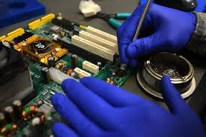Description
Many SMT operations struggle with “process issues” that are actually solder paste-related and have been resolved in newer generations of the materials. Nagging defects like tombstones, solder balls, excessive voids and Head-In-Pillow can often be mitigated with a change of solder paste. Newer formulations print better, wet better, endure hot reflow cycles better, and void less than older ones.
In the world of solder pastes, one size does not fit all, which is why there are so many variants to choose from.
The myriad of options can be overwhelming, and matching the right product to any given operation can be confusing, time consuming and costly:
• Solder paste has many conflicting properties – one that prints well may not pin test well, or one that minimizes voiding may reflow well, and tradeoffs must be considered
• Developing test methods takes a great deal of engineering time and experience
• Executing the tests requires engineering and production line time
• Production boards are expensive test vehicles and may not test every property
• Laboratory test boards often require a lot of manual setup and may not test every property, requiring multiple boards, setups and test runs
About the Presenters:
Chrys Shea is the President of Shea Engineering Services, a consulting firm that produces technical studies and communications tools for the electronics manufacturing industry. Chrys is a frequent speaker at industry events and has three times received the SMTAI “Best of Conference” award for her work on solder paste printing. In 2012 she was honored with the SMTA “Member of Technical Distinction” award. Chrys earned her B.S. in Mechanical Engineering from the University of Massachusetts and her M.S. in Manufacturing Engineering from the University of Rhode Island. She is a past president of the Philadelphia SMTA chapter, and sits on numerous IPC and SMTA technical committees. Chrys launched Shea Engineering Services in 2008.
Douglass Dixon is the Marketing Communications Director for Henkel Electronic Materials LLC and is responsible for managing all of the business unit’s global marketing communication activities. With over 20 years of electronics industry experience, Dixon has a broad skill set that includes engineering, field service, applications, product management and marketing communications expertise. Since joining Henkel in 2001, Dixon’s role has centered on strategic communications initiatives that have significantly raised the company’s profile within the global electronics market. During his tenure at Henkel, Dixon has also championed multiple service initiatives on behalf of the company that have made a positive impact on the communities in which Henkel Electronic Materials employees live and work. Examples include Henkel’s work with Think Together, a California-based organization dedicated to encouraging children to stay in school; and the Tianhua Orphan Education Project, a Chinese charity that provides full educational assistance for orphaned children. Dixon holds an Engineering degree from the University of Utah and, in his current role with Henkel, is based in the company’s Irvine, California facility.


 This 90-minute webinar recording reviews the initial test plan, data collection and analysis processes, and presents the results of the original study. It discusses some of the issues encountered during test development and their resolutions or workarounds. It then interprets the findings using a scorecard method that helps the user weigh the importance of individual solder paste performance characteristics to their operation.
This 90-minute webinar recording reviews the initial test plan, data collection and analysis processes, and presents the results of the original study. It discusses some of the issues encountered during test development and their resolutions or workarounds. It then interprets the findings using a scorecard method that helps the user weigh the importance of individual solder paste performance characteristics to their operation.